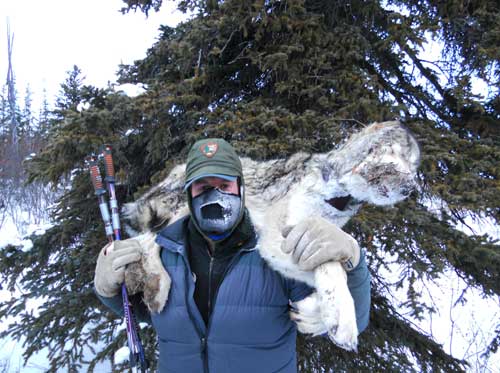
Lone wolf's days of wandering are over
May 15, 2012
When I last wrote about the wolf in August 2011, the silvery black creature was somewhere in the rolling tundra east of Deadhorse, having traveled more than 1,500 miles from its former home in Yukon-Charley Rivers National Preserve on the Yukon River last summer. The wolf was on a journey of great risk/reward, said John Burch, a biologist who fitted it with a collar that transmitted GPS coordinates to satellites every few days.
Seth McMillan of the National Park Service recovers the body of a male wolf that roamed more than 2,000 miles in seven months. The wolf died of starvation; McMillan is pictured where he and John Burch found it beneath a spruce tree near the upper Kanuti River.
The big Yukon-Charley male seemed to have had some luck at the latter, at least for a while. “He appeared to settle down for a bit on the North Slope,” Burch said. “I would guess he found a mate for a while. But they broke up for some reason and he headed south again.” After a few weeks of stability in the northern foothills of the Brooks Range, the wolf headed south as winter set in. It loped through a low mountain pass and padded down the Chandalar and upper Koyukuk river drainages. The wolf continued south to once again cross the Arctic Circle a few hundred miles west of where it last May passed the imaginary line going northward. The satellite transmitter told Burch the wolf wandered to a manmade barrier border it never crossed — the Dalton Highway — and then retreated a bit northward to the Kanuti River, about a mile east of the road. There, last October 18, signals from the satellite collar indicated the wolf had stopped moving. Burch and Seth McMillan went out to recover the collar from the wolf. They found it curled up under a spruce tree, dead. “He was really emaciated,” Burch said. “He weighed 69 pounds from the 103 he weighed when we collared him.” The wolf starved to death. Burch knows this from its body condition and because Alaska Department of Fish and Game veterinarian Kimberly Beckman examined the wolf and didn’t find any debilitating injuries or a crippling load of parasites. “I think (starvation in wolves) is more common than people think it is,” Burch said. “I think there’s some misconception about wolves being able to kill whenever they want to. Sometimes wolves can kill anything they want any time they want. Sometimes they can’t.” The wolf had felt the ache of deep hunger before. A few months after his mate in Yukon-Charley and he were both fitted with collars, biologists noticed that the pair kept coming back to the same moose carcass, even after little remained but scattered bones and hair. The female died there, also of starvation. Soon after, the male took off northward on his impressive journey. Burch found it interesting but not surprising that in its 2,085 miles of travel in half a year, the wolf never seemed to cross a road, though it probably came close enough to the Dalton Highway to hear the groan of trucks and smell burned diesel. “He may never have encountered a road or vehicles,” Burch said. “Wolves are cagy and reluctant with things that are unknown. It helps them stay alive.” The lone, wandering wolf has again showed Burch, who has studied wolves for decades, a few things about their behavior; one of them is that though life in the pack is good for many wolves, non-dominant wolves that don’t get to breed will often split. And even dominant wolves take off. “Biologists choose to capture and collar the alpha or breeding pair that are least likely to disperse, but still, even they disperse sometimes,” Burch said. “It makes you think, ‘Man, there must be a lot of wolves dispersing all over, all the time.’ Those dispersing wolves are looking for a place to live, and it doesn’t take long to repopulate an area once wolves have been killed. It’s a big factor in wolf population dynamics. “And it’s not that wolves are doing something different,” Burch said. “It’s that we’re able to see it now (with GPS collars in addition to radio collars tracked by airplane).”
This column is provided as a public service by the Geophysical Institute, University of Alaska Fairbanks, in cooperation with the UAF research community.
E-mail your news &
photos to editor@sitnews.us
|
||
